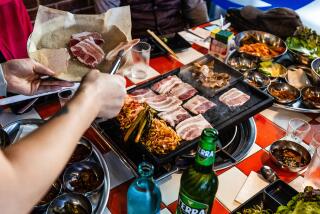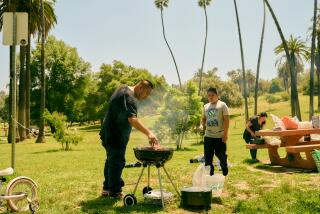Weber Grill Fans’ Devotion Burns Strong
- Share via
PALATINE, Ill. — For thousands of avid Weber grill users, the question isn’t really gas or charcoal. It’s how to fit multiple versions of each on their back patios.
John Gerald Gleeson has four Webers on the deck of his home in Gaylord, Mich. -- from Weber’s humble charcoal kettle to a $2,200 stainless steel job with six burners. His specialties include a slow-cooked ham braised in a bourbon-brown sugar glaze.
“I’ve used other grills in the past, before I saw the light,” the retired attorney said.
Gushing customer testimonials are the norm for Weber, which has become an iconic American brand in the 55 years since founder George Stephen created his three-legged kettle -- a backyard oddity that his neighbors came to call “Sputnik.”
As the image of Weber’s apple-shaped kettle has endured, Palatine-based Weber-Stephen Products Co. has coupled it with a reputation for durability and simplicity that has fostered a cult-like following.
“You ask just about anybody who owns a Weber -- I don’t think they ever have to buy another one,” said Chris Schlesinger, owner of East Coast Grill & Raw Bar in Cambridge, Mass., and author of several books on grilling.
Memorial Day weekend marks the unofficial start of barbecue season: Fully 62% of grill owners say they barbecue then, second only to the Fourth of July holiday at 74%, according to a 2005 survey by the Hearth, Patio & Barbecue Assn.
Weber competes with W.C. Bradley Co., owner of the Char-Broil brand, for dominance in the U.S. grill market -- valued at nearly $2.3 billion last year, according to market researcher NPD Group.
It’s a vast but saturated market, with 81% of U.S. homes owning outdoor grills in 2005, the barbecue association said.
The trade group also found that customers were buying larger, more sophisticated grills -- an indication that there is room for growth.
Neither company discloses sales figures; both are private and family owned. Columbus, Ga.-based Char-Broil says it has the upper hand in both revenue and unit shipments. Weber says the two are neck and neck and together account for about half of the U.S. market.
But few doubt that Weber enjoys an edge in brand recognition. For many, it has reached that rare status in which the brand becomes the product, like Tabasco or Coke.
Customer devotion is evident on a website Weber launched last month as a forum for customers’ favorite grill stories: One guy wrote a haiku about his six Weber grills. An Ohio woman claims to have used her Weber to cook an entire Christmas Eve dinner -- including a rib roast, potatoes and veggies -- after an ice storm knocked out power.
A Michigan woman even wrote to express joy over keeping her Weber charcoal kettle in her divorce settlement.
“It has been MUCH more faithful than my ex-husband!” she wrote.
The Weber grill dates to 1951, when Weber Bros. Metal Works employee George Stephen launched his quest for a better barbecue by slicing in half a metal buoy otherwise destined for the Chicago Yacht Club. He used it to fashion a kettle-shaped bowl and lid.
His theory: Allow enough airflow underneath the bed of coals to keep them hot, but use the lid to suffocate the briquettes just enough to prevent the flare-ups common in the shallow-pan barbecues of his day.
The system worked, although it would take some convincing.
“Dad would literally load the grill into a station wagon, go to a hardware store and set up a demonstration,” said son Jim Stephen, chief executive of Weber-Stephen since his father’s death in 1993.
“He would cook a turkey or a pig or something, and people would be in awe,” Stephen said.
It turns out form was just as important as function: The modest kettle design seared itself into the consciousness of generations of backyard tong twirlers.
“It wasn’t only a revolutionary grill, but it was a grill with personality,” said Steven Raichlen, author of “The Barbecue Bible” and host of a barbecue show on public television that Weber co-sponsors.
Stephen eventually fine-tuned a method of “indirect” cooking: positioning coals at the edges of the grill and placing a drip pan underneath the meat, allowing it to slow-cook while being infused with a smoky flavor.
“It brought a gigantic number of food recipes into the backyard that could have never been done on previous grilling equipment,” Raichlen said.
Of course, grilling is an art form, and not everyone subscribes to the Weber way.
Restaurant owner Schlesinger said Weber’s insistence on covering the grill even when cooking directly over the coals -- allowing sizzling fat to drip directly onto the briquettes -- has led millions of grillers astray.
“It’s way easier because you just throw the lid on and you don’t have to think about it,” he said. “But it gives the food this greasy smoke flavor. It’s a crummy way to grill.”
Weber introduced its first line of gas grills in the mid-1980s. These days it manufactures most of its products in-house, with shipments divided about evenly between charcoal and gas, Stephen said.
At a plant west of Palatine in Huntley, flat slabs of steel are pressed into the trademark kettle shape, coated in porcelain enamel and fired in a massive furnace at 1,600 degrees.
Engineers at Weber’s 50-person research-and-development shop routinely torture-test the products -- one stainless steel gas grill has been burning full bore for six months at 850 degrees.
Others are soaked in saltwater to see how they will withstand coastal environments, Weber Executive Vice President Mike Kempster said.
Weber must be doing something right, said Ann Chilton, owner of Annie’s Sazarac tavern in Beardstown, Ill. Every Monday she grills as much as 90 pounds of her signature ribs on three Weber charcoal kettles in her cook shack out back.
“It’s so easy to control the heat,” Chilton said. “I just set the temperature and cook on them all night long.”
*
(BEGIN TEXT OF INFOBOX)
‘Cue & A
* Company: Weber-Stephen Products Co., maker of Weber brand grills.
* Location: Headquarters in Palatine, Ill., with a manufacturing facility in Huntley, Ill.
* What it does: Manufactures and distributes charcoal and gas grills in all 50 states and about 40 countries. Employs 2,200 workers.
* History: George Stephen
creates the first Weber kettle grill from a metal harbor buoy in the early 1950s while employed at Weber Bros. Metal Works. Weber starts selling gas grills in the mid-1980s.
* Ownership: The private, family- owned company is run by Chief Executive Jim Stephen, son of founder George Stephen.
* Competition: Weber competes with W.C. Bradley Co., maker of Char-Broil. They are the two major players in the U.S. outdoor grill market.
* Market: The U.S. outdoor grill industry had nearly $2.3 billion in sales in 2005, according to market research firm NPD Group.
Source: Associated Press
More to Read
Inside the business of entertainment
The Wide Shot brings you news, analysis and insights on everything from streaming wars to production — and what it all means for the future.
You may occasionally receive promotional content from the Los Angeles Times.










